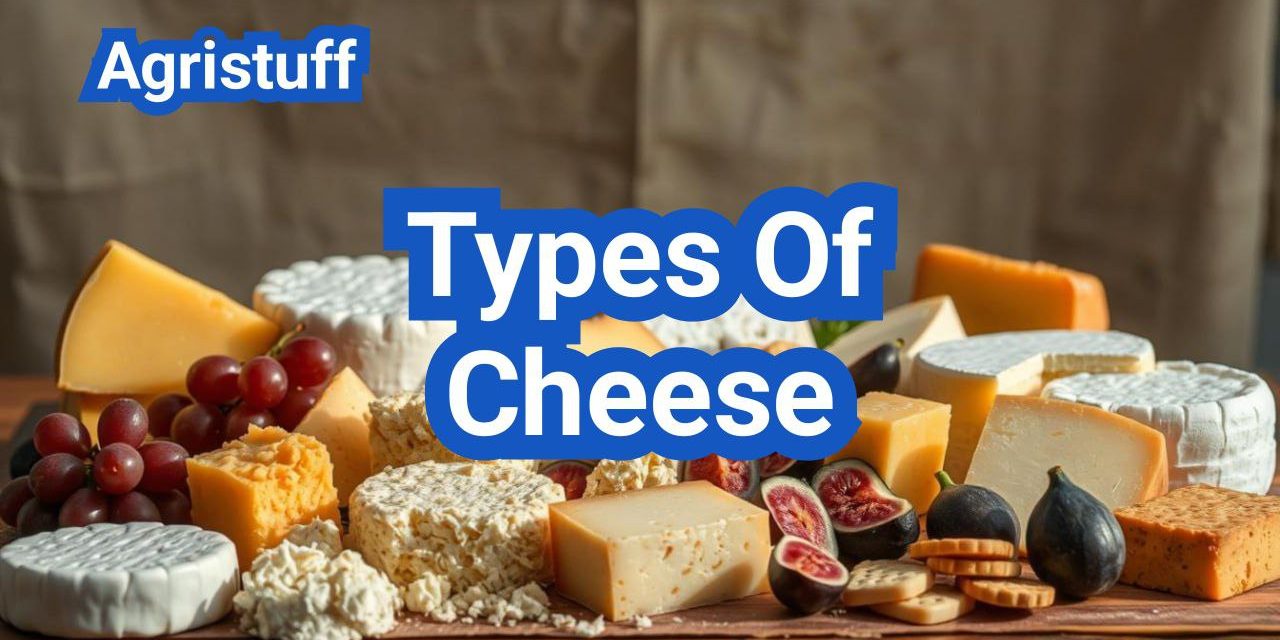The world of cheese varieties is vast and diverse, offering a multitude of flavors and textures that cater to different tastes and culinary uses. Understanding the various types of cheese can elevate cooking and enhance dining experiences.
A comprehensive cheese guide is essential for navigating the complexities of cheese, from soft brie to hard parmesan, and everything in between. This guide aims to explore the different categories of cheese, their characteristics, and uses.
Key Takeaways
- Understanding the main categories of cheese.
- Exploring the characteristics of different cheese varieties.
- Learning about the various uses of cheese in cooking.
- Discovering the diversity within soft, hard, and blue cheeses.
- Enhancing culinary skills with a comprehensive cheese guide.
The World of Cheese: A Brief Overview
With its rich history and diverse production methods, cheese is a fascinating topic. Cheese is a dairy product made from the proteins and fats in milk, typically from cows, goats, or sheep. The process of making cheese involves curdling milk, separating it into curds and whey, and then processing the curds into various forms.
What Defines Cheese
Cheese is defined by its production process, which involves coagulating milk to separate it into solid curds and liquid whey. The curds are then processed, shaped, and aged to create a wide range of cheeses. The type of milk used, the cheesemaking techniques, and the aging process all contribute to the final flavor, texture, and appearance of the cheese.
The characteristics of cheese can vary significantly, from soft and creamy to hard and granular. Understanding what defines cheese helps in appreciating its diversity and complexity.
The History of Cheesemaking
The history of cheesemaking dates back thousands of years, with evidence suggesting that cheese was first made around 8,000 years ago. The process likely originated in the Middle East, where nomadic tribes carried milk in animal stomachs, which contained rennet that caused the milk to curdle.
Over time, cheesemaking techniques spread throughout Europe, where different cultures developed their unique methods and recipes. Today, cheese is enjoyed worldwide, with a vast array of types and flavors available, reflecting the rich history and cultural diversity of cheesemaking.
How Cheese is Made: From Milk to Table

The art of cheesemaking transforms milk into a diverse array of cheeses enjoyed worldwide. This transformation involves several key steps and ingredients that vary depending on the type of cheese being produced.
The Basic Cheesemaking Process
The cheesemaking process begins with curdling milk, which involves adding enzymes or acid to separate the milk into curds (solid parts) and whey (liquid parts). The curds are then cut, stirred, and cooked to release more whey and create a smooth, even texture.
After the curds have been sufficiently processed, they are molded into their desired shape and left to age. The aging process is crucial as it develops the flavor and texture of the cheese. Different cheeses are aged for varying lengths of time, from a few weeks to several years.
Key Ingredients in Cheese Production
The primary ingredient in cheese production is milk, which can come from cows, goats, sheep, or a combination thereof. The type of milk used significantly affects the flavor and texture of the final product.
Other essential ingredients include rennet (an enzyme that helps curdle the milk), bacterial cultures (which contribute to the flavor and texture), and salt (used for flavor and as a preservative).
Understanding the Different Types of Cheese
The diverse world of cheese can be understood by exploring the different classification methods, such as texture, aging, and milk source. Cheese classification is crucial for appreciating the variety of cheeses available and for selecting the right cheese for specific culinary applications.
Classification by Texture and Aging
Cheese can be broadly classified based on its texture and aging process. Texture ranges from soft and creamy to hard and granular. Soft cheeses, like Brie and Camembert, have a creamy interior and a white rind. Hard cheeses, such as Parmesan and Cheddar, are aged for a longer period, resulting in a denser, often granular texture.
Aging is another critical factor in cheese classification. Fresh cheeses are not aged and are often soft and mild. Aged cheeses, on the other hand, are matured for a period that can range from a few months to several years, developing stronger flavors and textures.
| Texture | Aging Process | Examples |
|---|---|---|
| Soft | Short or no aging | Brie, Camembert |
| Hard | Long aging | Parmesan, Cheddar |
Classification by Milk Type
The type of milk used in cheese production significantly affects its flavor, texture, and overall character. Cow’s milk is the most commonly used, producing a wide range of cheeses, from Cheddar to Mozzarella.
Goat’s milk cheeses, such as Chevre, are known for their tangy flavor and soft texture. Sheep’s milk produces rich, creamy cheeses like Feta and Roquefort. Buffalo milk is used to make Mozzarella di Bufala, renowned for its use on pizzas.
| Milk Type | Characteristics | Examples |
|---|---|---|
| Cow | Varied texture and flavor | Cheddar, Mozzarella |
| Goat | Tangy, soft | Chevre |
| Sheep | Rich, creamy | Feta, Roquefort |
Fresh Cheeses: Delicate and Unaged

The world of fresh cheeses is vast and varied, encompassing a range of textures and flavors suitable for both sweet and savory dishes. Fresh cheeses are characterized by their minimal processing and lack of aging, which preserves their delicate flavors and soft textures.
Cottage Cheese, Ricotta, and Cream Cheese
Cottage cheese, Ricotta, and Cream cheese are among the most popular types of fresh cheeses. Cottage cheese is known for its lumpy texture and mild flavor, making it a great addition to salads or as a snack on its own. Ricotta, with its soft and creamy texture, is often used in Italian cuisine, particularly in dishes like lasagna and cannoli. Cream cheese, with its rich and tangy flavor, is a staple in many spreads and desserts.
How to Use Fresh Cheeses in Recipes
Fresh cheeses can be incredibly versatile in recipes. Cottage cheese can be blended into smoothies or used as a base for dips. Ricotta can be mixed with herbs and spices to create a delicious filling for pasta or as a topping for pizzas. Cream cheese can be softened and mixed with fruit preserves for a sweet spread or used in cheesecakes and frostings.
As
“The beauty of fresh cheeses lies in their simplicity and adaptability, allowing chefs and home cooks alike to experiment with a wide range of flavors and textures.”
To incorporate fresh cheeses into your cooking, consider their texture and flavor profile. For instance, mixing ricotta with spinach and garlic creates a delicious filling for ravioli, while blending cottage cheese with fruit can make for a healthy and tasty snack.
Soft-Ripened Cheeses: Creamy and Bloomy
Soft-ripened cheeses are a delight to the palate, offering creamy textures and bloomy rinds that elevate any cheese platter. These cheeses are characterized by their white or light-colored rinds and soft, often spreadable, interiors.
Brie, Camembert, and Triple Cremes
Brie and Camembert are two of the most well-known soft-ripened cheeses, originating from France. Brie is typically made from cow’s milk and has a mild, earthy flavor, while Camembert has a stronger, more pronounced taste. Triple creme cheeses, such as those produced by the renowned cheesemaker Isigny Ste-Mère, are enriched with additional cream, resulting in an exceptionally rich and buttery texture.
These cheeses are often described as having a bloomy rind, due to the white mold that grows on their surface during the ripening process. This mold not only contributes to their characteristic appearance but also plays a crucial role in developing their complex flavors.
Serving and Pairing Soft-Ripened Cheeses
Soft-ripened cheeses are best served at room temperature, allowing their full flavor and texture to be appreciated. They can be paired with a variety of accompaniments, such as fresh fruit, artisanal bread, and charcuterie. For a classic combination, try pairing Brie with a baguette and a selection of fresh berries.
When it comes to wine pairing, soft-ripened cheeses complement a range of varieties. A dry white wine, such as Sauvignon Blanc, pairs nicely with the creamy texture and mild flavors of Brie, while a richer, more aged Camembert can be matched with a robust red wine like Pinot Noir.
“The art of cheese pairing is not just about the cheese; it’s about creating a harmonious balance between the cheese, the accompaniments, and the beverage.” –
Renowned cheesemonger, Laurent Dubois
Semi-Soft ( Semi-Hard )Cheeses: Versatile and Meltable

The world of semi-soft cheeses is vast and varied, encompassing a range of flavors and textures that can elevate any dish. These cheeses are characterized by their semi-soft texture, which makes them ideal for melting, slicing, and incorporating into various recipes.
Havarti, Gouda, and Fontina Varieties
Semi-soft cheeses include a variety of popular types, such as Havarti, Gouda, and Fontina. Havarti is known for its mild, buttery flavor, while Gouda can range from mild and creamy to sharp and nutty, depending on its age. Fontina, with its nutty and mild flavor profile, is another versatile option that works well in cooking and as a table cheese.
These cheeses are not only delicious on their own but also bring a richness and depth to dishes when used in cooking. Their meltability makes them perfect for grilled cheese sandwiches, sauces, and casseroles.
Cooking Applications for Semi-Soft Cheeses
Semi-soft cheeses are incredibly versatile in the kitchen. They can be melted, sliced, or crumbled, making them suitable for a wide range of culinary applications. For instance, Gouda is excellent in soups and sauces due to its melting properties, while Havarti can be used in grilled cheese or as a topping for crackers and bread.
Cooking Tips: When using semi-soft cheeses in recipes, it’s essential to consider their melting points and flavor profiles to achieve the best results. For example, Fontina is a great addition to risottos and pasta dishes, adding a rich, creamy texture.
By incorporating semi-soft cheeses into your cooking repertoire, you can add complexity and flavor to a variety of dishes, from comfort food to gourmet meals.
Hard Cheeses: Aged for Flavor
Hard cheeses are known for their robust flavors and firm textures, developed through an aging process that can last from months to years. This aging process concentrates the flavors, making hard cheeses a favorite among cheese enthusiasts. With a variety of types to choose from, hard cheeses can be used in numerous dishes or enjoyed on their own.
Popular Types of Hard Cheeses
Some of the most well-known hard cheeses include cheddar, parmesan, and aged gouda. Cheddar, originating from England, is known for its sharpness, which increases with age. Parmesan, an Italian staple, is often grated over pasta dishes, adding a salty, umami flavor. Aged gouda, from the Netherlands, offers a nutty, caramel flavor that is perfect for snacking or grating.
Using Hard Cheeses in Cooking
Hard cheeses are versatile and can be used in various ways. They can be grated over dishes like pasta and salads, melted in sandwiches, or served on a cheese board. The key to using hard cheeses effectively is understanding their melting properties and flavor profiles. For instance, parmesan is ideal for grating due to its granular texture, while cheddar melts well, making it perfect for sauces and grilled cheese sandwiches.
As “The cheese is not just a food, it’s a sensory experience”, a quote that resonates with cheese lovers, hard cheeses offer a rich sensory experience, with their robust flavors and varied textures. Whether you’re grating parmesan over a pasta dish or slicing cheddar for a sandwich, hard cheeses are sure to enhance your culinary creations.
Blue Cheeses: Bold and Distinctive

With their distinctive veining and robust flavors, blue cheese offer a unique gastronomic experience. These cheeses are characterized by their strong, pungent flavors and veiny appearance, which are a result of the cheese-making process involving the introduction of a type of mold.
Blue cheeses have been a staple in many cuisines for centuries, with varieties such as Roquefort, Gorgonzola, and Stilton being among the most renowned. Each of these cheeses has its own unique characteristics, from the tangy, slightly sweet flavor of Gorgonzola to the bold, pungent taste of Roquefort.
Roquefort, Gorgonzola, and Stilton
Roquefort, Gorgonzola, and Stilton are three of the most celebrated blue cheeses. Roquefort, made from sheep’s milk, is known for its rich, tangy flavor and is often considered a delicacy. Gorgonzola, an Italian blue cheese, can range from creamy and mild to sharp and tangy, depending on its age. Stilton, a English blue cheese, is rich and complex, with a deep, mellow flavor.
- Roquefort: Made from sheep’s milk, known for its rich, tangy flavor.
- Gorgonzola: Italian blue cheese, ranges from creamy and mild to sharp and tangy.
- Stilton: English blue cheese, rich and complex with a deep, mellow flavor.
How to Appreciate Blue Cheese Flavors
Appreciating blue cheese flavors involves understanding their complexity and bold characteristics. To fully enjoy blue cheeses, it’s recommended to serve them at room temperature, which allows their full flavor profile to be appreciated. Pairing blue cheese with sweet accompaniments like fruit or honey can also enhance its flavor.
“The best way to appreciate blue cheese is to experience it in its various forms and pairings, allowing its bold flavors to be the centerpiece of your culinary experience.”
Experimenting with different blue cheeses and recipes can also help in appreciating their unique flavors. Whether it’s crumbling Gorgonzola into a salad or serving Roquefort as a dessert cheese with pears, the versatility of blue cheeses makes them a fascinating category to explore.
Washed-Rind Cheeses: Aromatic and Complex

Washed-rind cheeses, often referred to as “stinky cheeses,” offer a complex gastronomic experience. These cheeses are known for their strong aromas and are made using a specific cheesemaking process that involves washing the cheese in a brine solution during aging.
The “Stinky Cheese” Category Explained
The distinctive aroma of washed-rind cheeses comes from the bacteria that grow on their rinds during the aging process. This process involves regularly washing the cheese in a saltwater brine, which encourages the growth of these bacteria, resulting in the characteristic strong smell.
The flavor profile of these cheeses is equally complex, ranging from fruity to nutty, with a deep, rich taste that develops over time.
Epoisses, Taleggio, and Limburger
Some of the most famous washed-rind cheeses include Epoisses, Taleggio, and Limburger. Epoisses, a French cheese, is known for its pungent aroma and is often served as a dessert cheese, accompanied by a sweet white wine.
Taleggio, an Italian cheese, has a milder flavor compared to Epoisses but still retains the characteristic washed-rind aroma. Limburger, originating from Belgium, is perhaps the most infamous for its strong smell, often compared to sweaty gym socks.
| Cheese | Origin | Aroma | Flavor |
|---|---|---|---|
| Epoisses | France | Pungent, strong | Rich, fruity |
| Taleggio | Italy | Mildly pungent | Fruity, slightly sweet |
| Limburger | Belgium | Very strong, earthy | Mild, creamy |
Regional Types of Cheese Around the World

From the rolling hills of Europe to the innovative creameries of America, cheese traditions abound. The diversity in cheese production is a reflection of the rich cultural heritage and geographical characteristics of different regions.
European Cheese Traditions
Europe is renowned for its cheese, with countries like France, Italy, and Spain boasting a wide array of traditional cheeses. European cheese-making techniques have been refined over centuries, resulting in a rich variety of flavors and textures.
French and Italian Classics
France is famous for its soft-ripened cheeses like Brie and Camembert, while Italy is known for Parmesan and Mozzarella. These cheeses are not only staples in their respective cuisines but have also gained international acclaim.
Spanish, Swiss, and Dutch Varieties
Spain offers Manchego and Mahon, Switzerland is known for Emmental and Gruyère, and the Netherlands is famous for Gouda. Each of these cheeses has its unique characteristics, shaped by local milk production and aging processes.
American and New World Cheese Innovations
The Americas have also made significant contributions to the world of cheese, with the United States, in particular, emerging as a hub for artisanal and innovative cheese production. American cheesemakers have successfully adapted European techniques to create unique cheeses that reflect local flavors and preferences.
- Artisanal Cheeses: The U.S. has seen a surge in artisanal cheese production, with creameries experimenting with different milks, cultures, and aging processes.
- Innovative Flavors: Cheesemakers are incorporating local ingredients and flavors into their cheeses, creating products that are distinctly American.
How to Build the Perfect Cheese Board

A well-crafted cheese board is more than just a collection of cheeses; it’s an experience that delights the senses. Building the perfect cheese board involves a thoughtful selection of cheeses, accompaniments, and a visually appealing presentation.
Cheese Selection Principles
Selecting a variety of cheeses is crucial for a compelling cheese board. Consider a mix of textures and flavors by including soft-ripened, hard, and blue cheeses. For example, a soft-ripened Brie, a sharp Cheddar, and a pungent Gorgonzola can provide a nice balance. Aim for a range of milk sources, such as cow, goat, and sheep, to add depth to your selection.
| Cheese Type | Milk Source | Texture |
|---|---|---|
| Brie | Cow | Soft-Ripened |
| Cheddar | Cow | Hard |
| Gorgonzola | Cow | Blue |
Accompaniments and Presentation
Accompaniments can elevate your cheese board by adding contrasting flavors and textures. Consider including fruits, nuts, crackers, and jams. The presentation matters; arrange cheeses and accompaniments in a visually appealing way on a board or platter. Garnishes like fresh herbs can add a pop of color.
Serving Temperatures and Timing
Serving cheese at the right temperature is crucial for optimal flavor. Most cheeses are best served at room temperature. Plan ahead to allow cheeses to come to room temperature before serving. Timing is also important; consider replenishing the board as needed to keep it looking fresh and inviting.
By following these guidelines, you can create a cheese board that’s not only delicious but also visually appealing, making it a hit at any gathering.
Pairing Cheese with Wine and Other Beverages

Pairing cheese with the right beverage can significantly enhance its flavor profile. The key to a great pairing lies in balancing and complementing the flavors of both the cheese and the beverage.
When it comes to wine, certain classic pairings stand out. For instance, a rich, creamy Brie pairs beautifully with a light, crisp Sauvignon Blanc. On the other hand, a robust Cheddar is complemented by a full-bodied Cabernet Sauvignon.
Classic Wine and Cheese Pairings
Some of the most renowned wine and cheese pairings include:
- Chardonnay and Camembert: The buttery notes in Chardonnay complement the earthy flavors of Camembert.
- Pinot Noir and Gouda: The light, fruity flavors of Pinot Noir pair nicely with the nutty taste of Gouda.
Beer, Cider, and Non-Alcoholic Pairings
Beyond wine, other beverages offer exciting pairing possibilities. For example, a hoppy IPA can cut through the richness of a creamy cheese like Mascarpone, while a sweet cider can balance the tanginess of a goat cheese.
Some notable pairings include:
- Stout and Blue Cheese: The roasted flavors of stout complement the bold, pungent taste of blue cheese.
- Cider and Soft-Ripened Cheese: The sweetness of cider pairs well with the creamy texture of soft-ripened cheeses.
Cooking with Different Types of Cheese

The art of cooking with cheese involves understanding its different types and uses. Cheese can be a versatile ingredient, adding depth and richness to various dishes. Whether you’re melting it, grating it, or using it as a primary component, the type of cheese you choose can significantly impact the final product.
Melting Properties of Various Cheeses
Different cheeses have distinct melting properties. For instance, mozzarella and cheddar are known for their excellent melting capabilities, making them ideal for pizzas and grilled cheese sandwiches. On the other hand, cheeses like parmesan and gruyère are often grated or sliced thinly to incorporate into dishes.
Cheese-Focused Recipes and Techniques
Cheese can be the star of many recipes. For example, a classic macaroni and cheese is a comforting dish that showcases the creamy texture of melted cheese. Additionally, techniques like tempering cheese can enhance its melting properties, ensuring a smooth and even consistency in sauces and dips.
Substituting Cheeses in Recipes
When cooking, it’s often necessary to substitute one type of cheese for another. Understanding the characteristics of different cheeses can help in making these substitutions. For instance, if a recipe calls for gouda but you only have edam, you can still achieve a similar flavor profile due to their similarities in texture and taste.
Storing and Preserving Cheese Properly
To keep cheese fresh and delicious, understanding how to store it is vital. Proper storage not only maintains the quality of the cheese but also prevents premature spoilage.
Best Practices for Cheese Storage
Cheese storage requires a cool, humid environment. The ideal place is often the vegetable crisper drawer of your refrigerator, where the temperature is consistent and the humidity is higher. Wrap cheese in a breathable material like wax paper or aluminum foil, allowing it to breathe while preventing drying out.
| Cheese Type | Storage Wrap | Ideal Storage Temperature |
|---|---|---|
| Soft Cheeses | Wax Paper | 35°F – 45°F |
| Hard Cheeses | Aluminum Foil | 35°F – 45°F |
Signs of Spoilage vs. Natural Aging
Distinguishing between natural aging and spoilage is crucial. While some cheeses naturally develop strong odors or molds, others may be past their prime. Check for visible mold beyond the expected type and amount for that cheese variety. Sliminess or an ammonia-like smell can indicate spoilage.
“The key to enjoying cheese is understanding its aging process and storage needs.”
Nutritional Aspects of Different Cheese Types
Understanding the nutritional aspects of cheese is crucial for making informed dietary choices. Cheese can be a valuable source of nutrients, but its nutritional content varies widely among different types.
Cheese as a Source of Nutrients
Cheese is an excellent source of protein, calcium, and vitamins such as vitamin B12 and riboflavin. These nutrients are essential for maintaining healthy bones, teeth, and muscle function. For instance, a 1-ounce serving of cheddar cheese provides about 6 grams of protein and 20% of the daily recommended intake of calcium.
Considerations for Special Diets
For individuals on special diets, such as those requiring low-fat or low-sodium intake, certain types of cheese can be more suitable than others. For example, part-skim mozzarella or reduced-sodium feta can be good alternatives. It’s also important for those with lactose intolerance or dairy allergies to choose cheeses that are low in lactose or made from non-dairy sources.
Being mindful of the nutritional content of cheese allows consumers to enjoy its benefits while managing dietary restrictions.
Embracing the Diversity of Cheese
The world of cheese is incredibly diverse, with a wide range of types, textures, and flavors. From fresh cheeses like ricotta and cottage cheese to aged varieties like parmesan and cheddar, each type has its unique characteristics and uses.
Throughout this article, we’ve explored the different categories of cheese, including soft-ripened, semi-soft, hard, blue, and washed-rind cheeses. We’ve also discussed how to build a cheese board, pair cheese with wine and other beverages, and cook with various types of cheese.
The diversity of cheese is not just about the different types, but also about the regional traditions and innovations that shape the world of cheese. Whether you’re a cheese enthusiast or just starting to explore the world of cheese, there’s always something new to discover.
In conclusion, the richness and variety of cheese offer endless possibilities for culinary exploration and enjoyment. By embracing the diversity of cheese, you can elevate your cooking, entertain with style, and appreciate the craftsmanship that goes into creating these delicious products.
FAQ
What is the difference between soft-ripened and washed-rind cheeses?
Soft-ripened cheeses, like Brie and Camembert, are characterized by a white rind and a creamy interior, while washed-rind cheeses, such as Epoisses and Limburger, have a stronger aroma and a reddish-brown rind due to being washed in brine or liquor during aging.
How do I store cheese to maintain its quality?
Cheese should be stored in a cool, humid environment, wrapped in a breathable material like wax paper or cheese paper, and kept away from strong-smelling foods, as cheese can absorb odors easily.
What are the main categories of cheese based on texture?
Cheese can be categorized into several texture-based categories, including soft-ripened, washed-rind, semi-soft, and hard cheeses, each with its unique characteristics and uses in cooking.
Can I substitute one type of cheese for another in recipes?
Yes, but it’s essential to consider the flavor profile, melting properties, and texture of the cheese you’re substituting to ensure the desired outcome in your recipe.
How do I pair cheese with wine or other beverages?
Pairing cheese with beverages involves considering the flavor profiles and textures of both the cheese and the drink, with classic combinations including Chardonnay with Brie and Cabernet Sauvignon with Cheddar.
What are some common types of fresh cheeses?
Fresh cheeses include Cottage Cheese, Ricotta, and Cream Cheese, which are often used in recipes like lasagna, cheesecakes, and dips due to their mild flavors and versatile textures.
Are blue cheeses strong in flavor?
Yes, blue cheeses like Roquefort, Gorgonzola, and Stilton are known for their bold, pungent flavors and veiny appearance, making them a great addition to salads, dressings, and sauces.
What is the nutritional value of cheese?
Cheese can be a rich source of nutrients like calcium, protein, and vitamins, but it’s also high in calories, fat, and sodium, so moderation is key, especially for those on special diets.
How do I build a cheese board?
Building a cheese board involves selecting a variety of cheeses, accompaniments like crackers and fruit, and garnishes, and presenting them in an appealing way, with consideration for serving temperatures and timing
Can I age cheese at home?
Yes, but it requires a controlled environment with precise temperature and humidity levels, and a good understanding of the cheese’s aging process to avoid spoilage.
Conclusion of: Types Of Cheese
When U.S. shoppers compare the Types Of Cheese at the supermarket—fresh, soft-ripened, semi-soft, semi-hard, hard, blue, and specialty—they’re really choosing among different moisture levels, cultures, rinds, and aging methods that shape flavor, texture, and cooking performance; this guide to Types Of Cheese explains the science, safety, and smart buying tips you need to feel confident. American Cheese Society: Cheese style definitions
How experts define and group Types Of Cheese
Global food standards start most Types Of Cheese from the same baseline: milk is coagulated, whey is drained, curd is salted and shaped, and some cheeses are ripened; regulators then classify the Types Of Cheese by moisture, fat in dry matter, and ripening technique, which is why two cheeses may share a texture category yet taste very different. FAO/WHO Codex: General Standard for Cheese
Cheesemaking in brief: the engine behind all Types Of Cheese
All Types Of Cheese follow a similar make schedule—acidifying milk with starter cultures, adding rennet or heat/acid for coagulation, cutting and cooking curd, draining whey, salting, pressing (sometimes), and ripening (sometimes); the chef-like decisions about curd size, temperature, brining, and aging are what create the incredible spectrum of Types Of Cheese we enjoy. University of Guelph: Cheese science overview
Fresh cheeses (unripened): the “milk-forward” Types Of Cheese
Fresh Types Of Cheese such as cottage cheese, queso fresco, chèvre, mascarpone, and fresh mozzarella skip aging, keeping flavors clean and milky with a soft, moist body; these Types Of Cheese excel in salads, tacos, fruit plates, and desserts where delicate texture is a plus. ACS: Fresh cheese category
Ricotta and other heat-acid Types Of Cheese
Among fresh Types Of Cheese, ricotta stands out because it’s traditionally made by reheating whey and using acid to coagulate remaining proteins, producing a fine, lightly sweet curd that enriches lasagna, pancakes, and cheesecakes without heaviness; similar heat-acid Types Of Cheese appear in many cuisines. University of Guelph: Heat-acid (ricotta) cheeses
Soft-ripened cheeses: bloom-rind Types Of Cheese that ripen from the outside in
Soft-ripened Types Of Cheese like Brie and Camembert are sprayed with Penicillium camemberti, forming a white “bloomy” rind that digests the paste from the surface inward; this technique turns a chalky core into a creamy layer, making these Types Of Cheese stars on boards and elegant when baked. FDA: Brie/Camembert processing summary
Washed-rind cheeses: the bold, savory Types Of Cheese
Washed-rind Types Of Cheese are brushed or bathed with brine, beer, or wine to encourage surface bacteria that redden the rind and intensify aroma; despite their “stinky” reputation, these Types Of Cheese (like Limburger or Taleggio) often taste savory and meaty rather than harsh. ACS: Washed-rind styles
Semi-soft and semi-hard cheeses: flexible Types Of Cheese for melting and slicing
Middle-moisture Types Of Cheese—Havarti, Muenster, Fontina, young Gouda, and Monterey Jack—slice cleanly and melt evenly, which is why U.S. cooks reach for these Types Of Cheese on burgers, grilled cheese, casseroles, and quesadillas when they want creamy melt without oily separation. UW Center for Dairy Research: Moisture-based groupings
Pasta filata (stretched-curd): the pizza-perfect Types Of Cheese
Pasta filata Types Of Cheese such as mozzarella, provolone, Oaxaca, and string cheese are heated and stretched so proteins align, delivering signature stretch and excellent browning for pizza and baked pasta; low-moisture versions of these Types Of Cheese add structure and pull. U.S. Dairy Export Council: Pasta filata overview
Hard and extra-hard cheeses: concentrated, long-aged Types Of Cheese
Hard Types Of Cheese like Cheddar and Gruyère and extra-hard classics like Parmigiano Reggiano are pressed and matured for months or years, creating dense, crystalline textures and deep umami flavors; these Types Of Cheese shine finely grated on pasta or shaved over salads. University of Guelph: Firm-to-hard cheese technology
Blue cheeses: vividly ripened Types Of Cheese
Blue-veined Types Of Cheese are pierced to let oxygen feed Penicillium cultures; from creamy Gorgonzola to sharp Roquefort, the family spans mild to powerful, and these Types Of Cheese add savory contrast to steaks, salads, and honeyed toasts. eCFR: U.S. standards of identity for cheeses
Brined and pickled Types Of Cheese
Brined Types Of Cheese—best known by Feta—are stored in salty solutions that keep the curd moist, tangy, and crumbly; these Types Of Cheese are ideal in grain bowls, omelets, and chopped salads, and you can rinse lightly to moderate salt before serving. Codex: General cheese framework
Whey-based Types Of Cheese
Unlike most Types Of Cheese formed directly from milk, whey cheeses recover proteins remaining in whey after other cheeses are made; this gentle technique produces fine-grained curds with a lightly sweet profile, useful across both savory and dessert applications in many Types Of Cheese traditions. Codex: Whey cheese standard
Nutrition & portions: how Types Of Cheese fit a U.S. plate
Most Types Of Cheese provide high-quality protein, calcium, phosphorus, vitamin A, and B-12; because they’re concentrated, mindful portions matter—U.S. guidance counts 1½ oz of natural cheese (or 2 oz processed) as a Dairy Group “cup equivalent,” a handy rule across all Types Of Cheese. USDA MyPlate: Dairy Group equivalences
Balancing taste, sodium, and fat across Types Of Cheese
Different Types Of Cheese vary widely in sodium and fat: choose fresh goat cheese for tart lightness, part-skim mozzarella for everyday meltability, or aged Parmigiano for intense flavor used sparingly; rotating Types Of Cheese helps balance nutrition without sacrificing pleasure. U.S. Dairy: Cheese types & nutrition notes
Lactose & sensitivity: which Types Of Cheese are easier to digest?
If lactose is a concern, many aged Types Of Cheese—Cheddar, Swiss, Parmesan—contain very little lactose because whey is drained and cultures ferment residual sugars; small portions of these Types Of Cheese are often better tolerated. U.S. Dairy/NDC: Lactose in cheeses (PDF)
Lactose intolerance vs. milk allergy in Types Of Cheese
Lactose intolerance is digestive, while milk allergy is immune-mediated; people with true milk allergy should avoid all Types Of Cheese made from the offending milk and discuss safe alternatives with clinicians, since even trace exposure to Types Of Cheese can trigger reactions. NIDDK: Lactose intolerance basics
Safety first: pasteurized vs. raw milk Types Of Cheese
In the U.S., some Types Of Cheese may be made from unpasteurized milk, but federal policy requires raw-milk cheeses to be aged at least 60 days; even so, vulnerable groups should prefer pasteurized Types Of Cheese, especially softer styles, and always read labels carefully. FDA: Aged raw-milk cheese program
Foodborne risk awareness for soft Types Of Cheese
Soft Types Of Cheese made from unpasteurized milk carry a higher risk of Listeria, making pasteurized options the safer choice for pregnant people, older adults, and those with weakened immunity; this is true across many Types Of Cheese traditions worldwide. CDC: Listeria & dairy products
Storage & handling: keep every Type Of Cheese at its best
Good storage preserves quality across all Types Of Cheese: keep cheese refrigerated, rewrap opened pieces in breathable paper or vented containers, and use realistic timelines (fresh styles sooner, aged styles longer); proper storage extends enjoyment of your Types Of Cheese while limiting waste. FoodKeeper: Storage guidance
Label literacy: PDO/PGI and naming conventions in Types Of Cheese
Geographical indications help consumers understand certain Types Of Cheese: Europe protects historic names like Parmigiano Reggiano via PDO rules, while the U.S. allows domestic styles labeled “Parmesan” or “blue cheese”; learning which Types Of Cheese are protected clarifies what you’re buying. EU eAmbrosia: Parmigiano Reggiano (PDO)
Cooking with confidence: which Types Of Cheese melt, stretch, or brown?
For gooey pull, pasta filata Types Of Cheese like low-moisture mozzarella and provolone excel; for smooth sauces, many cooks blend semi-soft or young semi-hard Types Of Cheese that melt evenly; for browning, choose drier pizza-style blends formulated for ovens. USDEC: Pizza cheeses & blends
Entertaining & pairing: build a U.S. cheese board across Types Of Cheese
A balanced board mixes Types Of Cheese by texture and milk: a fresh goat cheese, a soft-ripened Brie-style, a semi-hard Jack or Gouda, a hard Cheddar or Parmigiano shard, and a blue; pair lighter Types Of Cheese with fruit and honey, and bolder Types Of Cheese with nuts and cured meats. ACS: Style families for planning
Buying tips in the U.S.: choose the right Types Of Cheese for the job
Let the dish drive your choice of Types Of Cheese: fresh for bright creaminess, semi-soft for gentle melt, pasta filata for stretch, hard for grating, blue for punch; read labels for milk type, pasteurization, and age, buy amounts you’ll finish in a week or two, and taste before you commit to larger wedges of new Types Of Cheese. USDA MyPlate: Making dairy choices
Quick FAQs on Types Of Cheese
Which Types Of Cheese are typically lowest in lactose? Aged Types Of Cheese such as Cheddar, Swiss, and Parmesan are usually very low in lactose because fermentation and aging reduce milk sugar, making these Types Of Cheese more tolerable for many people. U.S. Dairy: Low-lactose cheeses (PDF)
Which Types Of Cheese melt best for pizza or baked pasta? Pasta filata Types Of Cheese like low-moisture mozzarella and provolone deliver classic stretch, while blending in semi-soft Types Of Cheese boosts flavor without breaking the sauce. USDEC: Pasta filata guidance
Which Types Of Cheese should pregnant people avoid? Soft Types Of Cheese made from unpasteurized milk pose higher risk for Listeria; pasteurized Types Of Cheese are the safer pick, especially for soft styles. CDC: Dairy & Listeria safety
Final thought
From fresh ricotta to crystalline Parmigiano, the U.S. cheese case offers endless variety: choose Types Of Cheese to match your recipe or occasion—fresh for purity, soft-ripened for creaminess, semi-soft for easy melt, pasta filata for stretch, hard for savory depth, and blue for boldness; read labels, portion smartly, store well, and explore new Types Of Cheese one wedge at a time. FoodKeeper: Practical storage timelines
Sources & References
- FAO/WHO Codex General Standard for Cheese (CXS 283)
- FAO/WHO Codex Standard for Whey Cheeses (CXS 284)
- American Cheese Society: Definitions & Categories
- University of Guelph: Dairy Science & Technology—Cheese
- University of Guelph: Heat-acid (Ricotta) Cheeses
- UW Center for Dairy Research: Moisture-Based Groupings
- U.S. Dairy Export Council: Pasta Filata
- U.S. Dairy Export Council: Pizza Cheeses & Blends
- USDA MyPlate: Dairy Group Guidance
- U.S. Dairy/National Dairy Council: Lactose in Dairy Foods (PDF)
- NIDDK: Lactose Intolerance
- FDA: Aged Raw-Milk Cheese Program
- CDC: Listeria & Dairy Products
- FoodSafety.gov: FoodKeeper App
- EU eAmbrosia: Parmigiano Reggiano (PDO)
- eCFR: Standards of Identity for Cheeses













